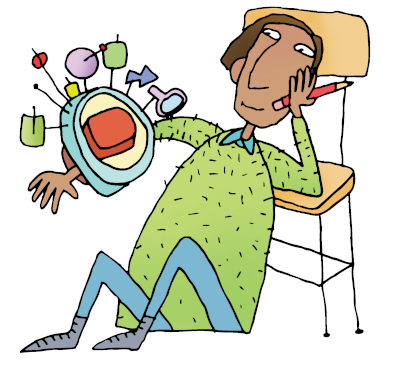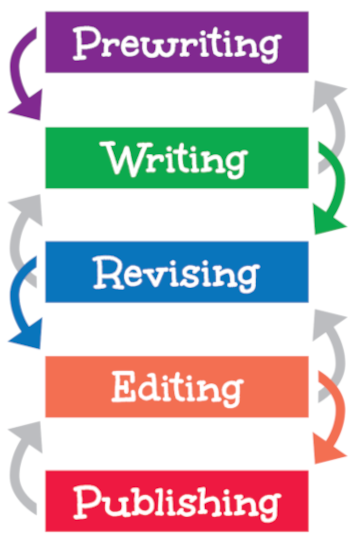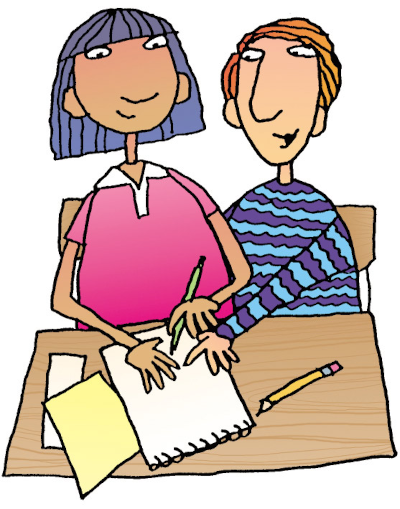Page 9
Understanding the Writing Process

These days, our digital devices can do many things for us. They take pictures of us, connect us with friends, track our steps, give us directions, tell us the weather, and wake us up in the morning.
When they try to write for us, though, it doesn’t go so well. Autocorrect changes our friend “Callum” into a “Camel.” And just try to write using predictive text: “Camel wants the bicycle yesterday whatever the birthday.” Even AI chatbots just assemble ideas from actual humans.
That’s because digital devices can’t think, and writing is thinking. Writing lets your brain talk to other brains. You have a thought and put it into words and sentences. Then a reader goes through those words and sentences to have the same thought—and many others!
Writing is a thinking process, and this chapter shows you the steps in that process.
What’s Ahead
WE 010
Page 10
Steps in the Writing Process

Prewriting takes you from not knowing what to write about to having a head full of ideas. You think about the assignment, identify a topic, collect details, and create a writing plan.
Writing the first draft means turning ideas into words. This draft is your first look at your writing—your chance to see how well things are coming together.
Revising lets you improve the ideas and structure of your writing. You read your writing, think about what you’ve written, and then add, cut, or change it as needed. Your goal is to make all of your ideas clear and complete.
Editing is checking your revised writing line by line for errors. You should also proofread for errors as you create the final copy of your writing.
Publishing refers to sharing the final copy of your writing. Publishing comes in many different forms depending on the purpose and audience for your writing.
Note During a writing assignment, you may repeat some of the steps. For example, after reviewing a first draft, you may collect more details for certain parts. The writing process almost always works this way, and a writer may go backward and forward any number of times before finishing an assignment. (See the graphic above.)
WE 011
Page 11
A Closer Look at the Process
These next two pages show what to do for each step in the writing process. If you follow the guidelines for each step, you should produce a strong piece of writing.
Prewriting
Study the Assignment 🟪 Be sure you know what is expected of you in terms of the Purpose, Audience, Subject, and Type of writing (PAST).
Pick a Specific Topic 🟪 Be sure to choose a topic that interests you and relates to the assignment.
Collect Details About Your Topic 🟪 First, gather your own thoughts; then collect details from other sources.
Find a Focus 🟪 Identify a main idea to focus on. This will prevent you from trying to say too much about your topic.
Make a Plan 🟪 Select details that support your focus, and organize them into a list, outline, or graphic organizer.
Writing
Put Your Ideas into Words 🟪 As you write, use your plan as a general guide, but also be open to new ideas that pop up.
Think of Your Audience 🟪 Write as if you were in a conversation with your readers.
Form a Complete Draft 🟪 Include a beginning, a middle, and an ending.
Revising
Review Your Writing 🟪 Read your first draft silently and then out loud. Identify parts that need work.
Share Your Draft 🟪 Ask a classmate, family member, or teacher to review your first draft.
WE 012
Page 12
Does the writing follow the guidelines for the assignment?
Does the beginning identify the topic and the focus and get the reader’s attention?
Do the details in the middle part support the focus? Are more details needed?
Does the ending restate the focus and make a final point?
Follow a Checklist 🟪 Use a revising checklist to guide your work.
Make Changes 🟪 Add, cut, move, or rewrite parts as needed to make your writing clearer and more complete. Use these questions as a guide.

Editing
Check for Accuracy 🟪 Correct any errors in capitalization, punctuation, usage, grammar, and spelling.
Follow a Checklist 🟪 Use an editing checklist to guide your work.
Get Editing Help 🟪 Ask a classmate or your teacher to check your writing for errors, too.
Check for Style 🟪 Make sure you use interesting words and smooth sentences.
Write a Neat Final Copy 🟪 Be sure to format your writing correctly. Proofread your final copy for errors.
Publishing
Present Your Writing 🟪 Share your final copy with your class or with the appropriate audience.
Add It to Your Portfolio 🟪 Include your best work in your portfolio.
"The first draft is the down draft—you just get it down. The second draft is the up draft [revising]—you fix it up. The third draft is the dental draft [editing], when you check every tooth to see if it is healthy.”
—Anne Lamott